I borrowed this idea from the internet, having recently seen similar articles about the NBA and NFL. It is an interesting concept.
My goal for this article is to identify the best players of the past half-decade. The first step is to determine how to select these All-Stars. How big a role does the phrase “half-decade” play in selecting players?
Player Selection
For Stapled To The Bench (STTB), the phrase “half-decade” plays a huge role in determining the Half-Decade All-Stars (HDAS). The search is for players who have played very well for the last five seasons, for all five seasons. Some players have played extremely well for a couple of the last five years who were not selected because their other seasons were “not up to snuff.”
How were players selected based on the last five seasons? For skaters, this was done by using the Productivity Rating. PR-Score is a number between 0 and 10-ish that describes a player’s total contribution in one season: the higher the number, the better the season. Skaters were selected based on their total PR-Score over the last five seasons.
Goalies were selected based on Goalie Expected Points (GxPts), which is the number of standing points a team could expect to have based on a goalie’s quality of play and ice-time.
Two HDAS teams were selected, a first team and a second team. Each team has twelve forwards, six defensemen and two goalies.
Are There Weaknesses in the Selection Method?
If you are asking me, the answer is a firm “no.” The selection method used calculations based solely on data from regular-season games in the last five seasons. Let me play devil’s advocate and explore some possible issues that might be raised.
Neither playoff games nor international games are included in the selection method. Productivity Rating is based on counted statistics, and playing more games would give players more counted statistics. But do good players play more playoff games, or do players on good teams play more playoff games? It’s the latter that is true. Some good players don’t even play playoff games, while some mid-level players play tons of playoff games.
Defensive players may be on the short end of the stick, as PR is based on NHL statistics and only a few of them have defensive implications. Does anybody really believe that a 40-goal scorer was less deserving to be an all-star than a great defensive forward who scores less than 20 goals? Remind me: who was the last low-scoring purely defensive forward who was selected to an all-star team?
An Example of the Calculations That Led to HDAS Determination
From 2013-14 through 2017-18, Erik Karlsson was one of the best players in the NHL (he had the highest Value Rating in three of those seasons). He had a massive 2022-23 season, but his 2020-21 and 2021-22 seasons were less than stellar. How does that all work out?
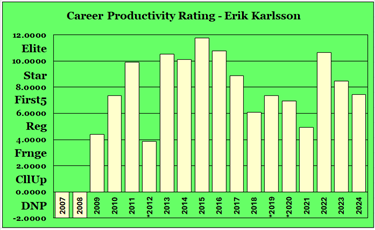
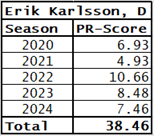
As the calculation table shows, Karlsson’s magnificent seasons from 2013-14 through 2016-17 don’t matter: they were before the five-year period we are looking at. His total PR-Score for the last five seasons (38.46) is the 16th highest among defensemen, and only the top twelve defensemen are included in the HDAS.
Half-Decade All-Stars, First Team

The first-team’s average season PR-Score was 9.62, which is towards the top of the PR-Star category. Of the 90 seasons (18 * 5) played by the skaters, there were 31 PR-Elite and 48 PR-Star seasons.
Hellebuyck is far and away the best regular season goalie from the last five seasons. He is 45.3 GxPts better than Vasilevskiy, which is worth 22½ wins over the half-decade. Should he be downgraded due to his sketchy playoff performances? For two reasons the answer is no: firstly, players were selected based solely on regular season performances; secondly, he’d still be in first place even if playoff performances were included. (Source: I ran the numbers.)
Half-Decade All-Stars, Second Team

The second-team’s average season PR-Score was 8.41, which is towards the bottom of the PR-Star category. Of the 90 seasons played by the skaters, the second team skaters produced 5 PR-Elite and 57 PR-Star seasons.
Saros and Shesterkin are close to each other, and they are close to Vasilevskiy. The difference between Vasilevskiy (2nd) and Shesterkin (4th) is 13.2 GxPts. The next best goalie (Ilya Sorokin) is just over 20 GxPts behind Shesterkin.
Skaters within 1.0 PR-Points of making the HDAS teams were: defensemen Darnell Nurse and Rasmus Andersson; forwards Jake Guentzel, John Tavares and Kirill Kaprizov.
Half-Decade All-Stars, Five-Season PR-Points (GxP for Goalies)
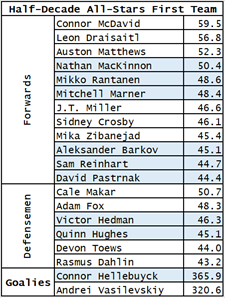
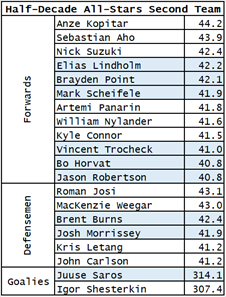
Seasons Played
All the players on both teams played all five seasons in the half-decade. The lowest total PR-Score of any HDAS skater is 40.8 (Bo Horvat, Jason Robertson).
Could a four-season skater make the HDAS? Yes, but his average PR-Score over those four seasons would have to be greater than 10.00, the equivalent of four PR-Elite seasons.
Moritz Seider (DET, D) has played only four seasons, and rated PR-Star in each of those seasons. With one more season at his current level of play, he will be a lock for the HDAS and almost certainly would be on the first team.
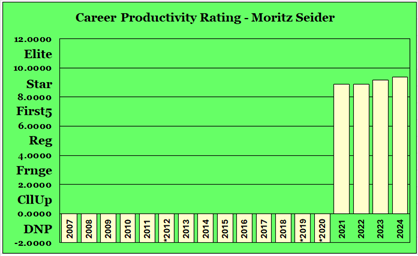
Seider presently ranks 29th among defensemen from the last five seasons, with many lesser lights ahead of him solely because they played all five seasons. Compare his chart with that of John Carlson, the 12th ranked defenseman.
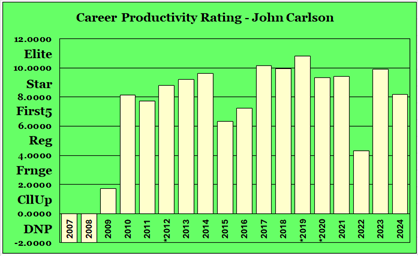
Three of Carlson’s last five seasons are as good as, or better than, Seider’s best season. Carlson’s 2024-25 season was good. In those four seasons, Carlson’s PR-Score total exceeds Seider’s (36.86 vs 36.29). And Carlson’s 2022-23 season further distances him from Seider and was just enough to put him into the last defenseman slot on the second HDAS team. That season has a low score because he missed half the season due to a gruesome injury caused by being struck in the side of his head by a slapshot.
Avoiding Three Biases in the Selection of All-Stars
Emotional bias happens when one relies on one’s feelings more than the facts. Any person selecting All-Stars based on his opinions is subject to emotional bias, regardless of his level of hockey knowledge. A professional sports commentator would be able to pick an excellent team, but might have a pick or two that are made on emotion or to appease the fan base of the team he works for. A Toronto-based commentator may think that John Tavares (TOR, F) should be included, simply because he likes Captain Pyjamas and sees a lot of his games. He was not selected for the HDAS teams because he ranked 26th amongst forwards.
As STTB used formulas to select HDAS players, there is no emotional bias.
Recency bias happens when one gives more importance to recent results. A person suffering from recency bias might argue that Moritz Seider should be included in the HDAS teams, given his last four seasons. His details can be found in the Seasons Played section.
Primacy bias happens when one gives more importance to historic results. A person suffering from primacy bias might argue that Ryan O’Reilly should be included in the HDAS, as he was one of the better players in the league from 2017-18 through 2020-21.
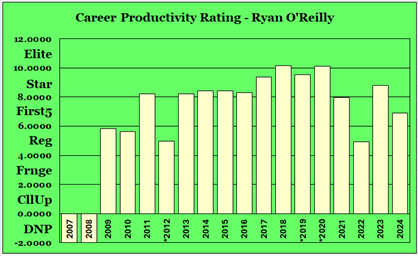
Unfortunately for Mr. O’Reilly, only his 2020-21 season is considered for this HDAS. He ranks 33rd amongst forwards and was not selected.
Summary #1
The mix of Elite and Star seasons between the two HDAS teams (31 and 48 vs. 5 and 57) shows that the first team is clearly stronger than the second team.
Summary #2
The selection process used to pick the HDAS players avoids three types of bias. A half-decade all-star team isn’t about players you like or players who played well over the last three seasons or players who played well seven years ago: it is about who has played well over all five seasons in the half-decade.
Summary #3
Taking STTB’s final shot at Ryan Reaves (TOR, F): he ranks 398th among forwards and would be on the 34th HDAS team.
Related Articles
